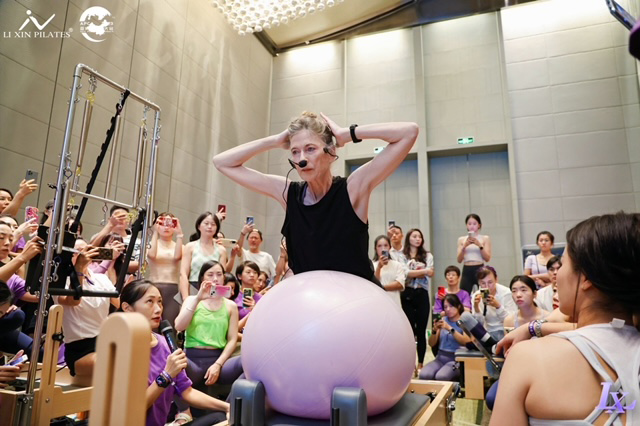When interventional spine doctor and Kuchipudi dancer Pranamya Suri was doing her medical residency, she had less time to dance than usual. When she did get the chance to practice, she noticed a persistent pain developing around and behind her kneecap. Suri identified this pain as a warning sign of patellofemoral pain syndrome (PFPS) and was able to rehabilitate using a combination of rest and targeted strengthening exercises.
Suri explains that it’s common for dancers to develop PFPS, but the condition is also highly treatable. By learning about PFPS and how it affects dancers, identifying warning signs early on, and applying mitigation tactics before it becomes an issue, dancers can safeguard their joints and set themselves up for a long, healthy career.

What Is PFPS?
PFPS is characterized by generalized pain around and behind the patella, or kneecap. It is usually exacerbated during instances of knee flexion (like grand pliés), walking up and down stairs, or even extended sitting. PFPS is an overuse injury—the more the quadriceps contract and the knees flex, the greater the force pushing the patella back against the underlying femur. The result is pain, explains Karen Clippinger, author of Dance Anatomy and Kinesiology and a professor emerita at California State University, Long Beach.
 Karen Clippinger. Courtesy LiXin Pilates.
Karen Clippinger. Courtesy LiXin Pilates.
“If you look at grand pliés and hinges and spirals to the floor, there are a lot of movements in dance that are associated with high compression forces, which puts dancers at risk for having this condition,” Clippinger says.
The turned-out positions favored in some dance styles might heighten a dancer’s risk for PFPS, adds Jennifer Coviello, a doctor of physical therapy specializing in treating dancers—especially if they struggle to track their knees over their toes in bent-leg positions. Hyperextension, too, can add risk if dancers over-rely on certain muscles, making the knee less stable, Clippinger explains.
 Jennifer Coviello. Courtesy Summit Physical Therapy.
Jennifer Coviello. Courtesy Summit Physical Therapy.
Treating PFPS
If you think you might be experiencing PFPS, it’s important to seek individualized attention from a medical professional. Most likely, you’ll work with a physical therapist to develop a repertoire of exercises tailored to your specific needs. It’s common for physical therapists to suggest strengthening the quads and the hip abductors. In some instances, dancers might also need to work further up the kinetic chain, strengthening the abdominals and obliques, Coviello explains. Tightness in the hamstrings and inner thighs can also contribute to PFPS, she says, so stretches that target this region may also be incorporated.
Suri adds that she sometimes uses tools like kinesiology tape and knee-bracing sleeves, but these shouldn’t substitute for the recommendations of a physical therapist or other medical professional. “They’re more of a proprioceptive reminder to help you guide your kneecap to go this way, not that way,” she says.
 Pranamya Suri. Photo by Rishi Raj, Courtesy Suri.
Pranamya Suri. Photo by Rishi Raj, Courtesy Suri.
Preventing Future Pain
Because many dance forms involve repetitive knee flexion, it’s important for dancers to think about PFPS before it’s an issue. Consider adjusting your cross-training routine to integrate some preventive measures. Clippinger recommends three simple exercises which target different PFPS culprits (see sidebar). You can also work your way up to these exercises by starting without the props.
Clippinger advises dancers to familiarize themselves with their own anatomy by palpating the front of the thigh above the kneecap as the quads contract. Make sure the inner and outer components of your quads are both contracting, as that will help your kneecap track properly in flexion. “It really takes a lot of focus and concentration to start finding how to activate that inner part and get it to contract,” she says.
Terminal knee extension with ankle weight
Place a prop, like foam roller or bolster, under your hamstrings. Make sure the knee is bent less than 30 degrees to keep compression forces low, Clippinger says.
Straighten the knee, palpating with your hand to gauge equal contraction of the inner and outer thigh muscles.
Hold for five seconds. Repeat for 3 sets of 10. Add an ankle weight for additional challenge.
 Photos (by Kirk Fitzek) and exercises adapted from Dance Anatomy and Kinesiology. Published by Human Kinetics. © 2024. Third Edition.
Photos (by Kirk Fitzek) and exercises adapted from Dance Anatomy and Kinesiology. Published by Human Kinetics. © 2024. Third Edition.
Side leg raise with band
With a TheraBand around your upper thighs, lie on one side.
Externally rotate your legs and lift your top leg, resisting the force of the band.
Hold for four counts in the end position, then repeat between 8–12 times, starting with one set and progressing to three.
Consider doing this exercise with your back to a wall, focusing on using the deep outward rotators by pressing into the wall with your pinky toe. This exercise helps develop the muscles that will allow your knee to track properly in external rotation, as well as strengthening the hip abductors, Clippinger says.
 Photos (by Kirk Fitzek) and exercises adapted from Dance Anatomy and Kinesiology. Published by Human Kinetics. © 2024. Third Edition.
Photos (by Kirk Fitzek) and exercises adapted from Dance Anatomy and Kinesiology. Published by Human Kinetics. © 2024. Third Edition.
Hip rotation on elbows
With a TheraBand around your thighs just above the knees, lean back with your weight supported by your forearms.
Externally rotate your legs, focusing on turning out from the hip, as opposed to the knee joint.
As you straighten the knees, avoid hyperextension. Instead, focus on using the same muscles you palpated in the first exercise.
Hold for four counts in the end position, then repeat between 8–12 times, starting with one set and progressing to three.
 Photos (by Kirk Fitzek) and exercises adapted from Dance Anatomy and Kinesiology. Published by Human Kinetics. © 2024. Second Edition.
Photos (by Kirk Fitzek) and exercises adapted from Dance Anatomy and Kinesiology. Published by Human Kinetics. © 2024. Second Edition.
Source link




GIPHY App Key not set. Please check settings